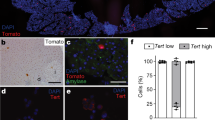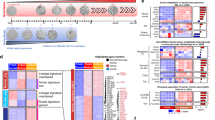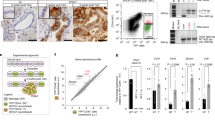Abstract
In a primary culture model for pancreatic acinar–ductal transdifferentiation, cells exhibited increased proliferation, changes in nuclearity and polyploidy. We identify the ‘nucleus to centrosome’ ratio of the progenitor cell, the dissemination of centrosomes at spindle poles and cytokinesis failure as critical determinants of mitosis outcome and centrosome inheritance. Abortive cytokinesis of mononuclear cells contributes to the binuclear cell pool, whereas enclosure of entire mitotic formations, within a single nuclear envelope, perpetuates polyploidization. Binuclear cell nuclei combine their genomes on a single metaphase plate, doubling descendant ploidy. Moreover, ∼42% of binuclear and tetraploid cells assemble aberrant spindles with up to 8 centrosomes/poles. These phenotypes were exacerbated in p53-deficient cultures exhibiting increased S-phase entry, giant nuclei, multinucleation, multipolar mitoses and centrosome hyperamplification. The tendency of p53-proficient cells to spontaneously evade the tetraploidy checkpoint degenerates to uncontrolled polyploid progression in p53-deficient cultures, explaining why p53 abrogation alone rapidly descends to aneuploidy in this system. We detected constitutively nuclear mdm2, which may circumvent endogenous cell-cycle checkpoints, and pronounced accumulation of p21 and p27 in multinuclear cells and giant nuclei, consistent with roles in polyploidization. This in vitro model may recapitulate the processes underlying genomic instability in pancreatic tumours in vivo, and attests to the existence of a p53-dependent polyploidy checkpoint acting to limit the degree of polyploidization.
This is a preview of subscription content, access via your institution
Access options
Subscribe to this journal
Receive 50 print issues and online access
$259.00 per year
only $5.18 per issue
Buy this article
- Purchase on Springer Link
- Instant access to full article PDF
Prices may be subject to local taxes which are calculated during checkout







Similar content being viewed by others
References
Andreassen PR, Lohez OD, Lacroix FB and Margolis RL . (2001). Mol. Biol. Cell, 12, 1315–1328.
Arias AE and Bendayan M . (1993). Lab. Invest., 69, 518–530.
Bardeesy N and DePinho RA . (2002). Nat. Rev. Cancer, 2, 897–909.
Bates S, Ryan KM, Phillips AC and Vousden KH . (1998). Oncogene, 17, 1691–1703.
Borel F, Lohez OD, Lacroix FB and Margolis RL . (2002). Proc. Natl. Acad. Sci. USA, 99, 9819–9824.
Bottinger EP, Jakubczak JL, Roberts IS, Mumy M, Hemmati P, Bagnall K, Merlino G and Wakefield LM . (1997). EMBO J., 16, 2621–2633.
Casenghi M, Mangiacasale R, Tuynder M, Caillet-Fauquet P, Elhajouji A, Lavia P, Mousset S, Kirsch-Volders M and Cundari E . (1999). Exp. Cell Res., 250, 339–350.
Clarke AR, Cummings MC and Harrison DJ . (1995). Oncogene, 11, 1913–1920.
Daujat S, Neel H and Piette J . (2001). Trends Genet., 17, 459–464.
Dazard JE, Piette J, Basset-Seguin N, Blanchard JM and Gandarillas A . (2000). Oncogene, 19, 3693–3705.
De Lisle RC and Logsdon CD . (1990). Eur. J. Cell Biol., 51, 64–75.
Fukasawa K, Choi T, Kuriyama R, Rulong S and Vande Woude GF . (1996). Science, 271, 1744–1747.
Guidotti JE, Bregerie O, Robert A, Debey P, Brechot C and Desdouets C . (2003). J. Biol. Chem., 278, 19095–19101.
Hall PA and Lemoine NR . (1992). J. Pathol., 166, 97–103.
Haroske G, Giroud F, Reith A and Bocking A . (1998). Anal. Cell Pathol., 17, 189–200.
Hong FD, Chen J, Donovan S, Schneider N and Nisen PD . (1999). Carcinogenesis, 20, 1161–1168.
Hoshi H and Logsdon CD . (1993). Am. J. Physiol., 265, G1177–G1181.
Khan SH and Wahl GM . (1998). Cancer Res., 58, 396–401.
Kikuchi J, Furukawa Y, Iwase S, Terui Y, Nakamura M, Kitagawa S, Kitagawa M, Komatsu N and Miura Y . (1997). Blood, 89, 3980–3990.
Lanni JS and Jacks T . (1998). Mol. Cell. Biol., 18, 1055–1064.
Lawlor MA and Rotwein P . (2000). Mol. Cell. Biol., 20, 8983–8995.
Lundgren K, Montes de Oca LR, McNeill YB, Emerick EP, Spencer B, Barfield CR, Lozano G, Rosenberg MP and Finlay CA . (1997). Genes Dev., 11, 714–725.
Matsumura I, Ishikawa J, Nakajima K, Oritani K, Tomiyama Y, Miyagawa J, Kato T, Miyazaki H, Matsuzawa Y and Kanakura Y . (1997). Mol. Cell. Biol., 17, 2933–2943.
Meraldi P, Honda R and Nigg EA . (2002). EMBO J., 21, 483–492.
Nagata Y, Muro Y and Todokoro K . (1997). J. Cell Biol., 139, 449–457.
Niculescu III AB, Chen X, Smeets M, Hengst L, Prives C and Reed SI . (1998). Mol. Cell. Biol., 18, 629–643.
Ornitz DM, Hammer RE, Messing A, Palmiter RD and Brinster RL . (1987). Science, 238, 188–193.
Poluha W, Poluha DK, Chang B, Crosbie NE, Schonhoff CM, Kilpatrick DL and Ross AH . (1996). Mol. Cell. Biol., 16, 1335–1341.
Purdie CA, Harrison DJ, Peter A, Dobbie L, White S, Howie SE, Salter DM, Bird CC, Wyllie AH, Hooper ML and Clarke AR . (1994). Oncogene, 9, 603–609.
Quaife CJ, Pinkert CA, Ornitz DM, Palmiter RD and Brinster RL . (1987). Cell, 48, 1023–1034.
Ramel S, Sanchez CA, Schimke MK, Neshat K, Cross SM, Raskind WH and Reid BJ . (1995). Pancreas, 11, 213–222.
Rooney RJ . (2001). Cell Growth Differ., 12, 505–516.
Roy L, Coullin P, Vitrat N, Hellio R, Debili N, Weinstein J, Bernheim A and Vainchenker W . (2001). Blood, 97, 2238–2247.
Sandgren EP, Quaife CJ, Paulovich AG, Palmiter RD and Brinster RL . (1991). Proc. Natl. Acad. Sci. USA, 88, 93–97.
Sato N, Mizumoto K, Nakamura M, Maehara N, Minamishima YA, Nishio S, Nagai E and Tanaka M . (2001). Cancer Genet. Cytogenet., 126, 13–19.
Sato N, Mizumoto K, Nakamura M, Nakamura K, Kusumoto M, Niiyama H, Ogawa T and Tanaka M . (1999). Clin. Cancer Res., 5, 963–970.
Scarpelli DG, Rao MS and Reddy JK . (1984). Environ. Health Perspect., 56, 217–227.
Sluder G and Nordberg JJ . (2004). Curr. Opin. Cell Biol., 16, 49–54.
Sphyris N, Logsdon CD and Harrison DJ . (2005). Pancreas, 30, (in press).
Tarapore P and Fukasawa K . (2002). Oncogene, 21, 6234–6240.
Uetake Y and Sluder G . (2004). J. Cell Biol., 165, 609–615.
Vila MR, Lloreta J and Real FX . (1994). Lab Invest., 71, 423–431.
Wang J and Walsh K . (1996). Science, 273, 359–361.
Wu H, Wade M, Krall L, Grisham J, Xiong Y and Van Dyke T . (1996). Genes Dev., 10, 245–260.
Acknowledgements
We thank Kirsten Atkinson for technical assistance, Helen Caldwell for primary hepatocytes and Sandrine Prost, Owen Sansom and Sally Wheatley for comments on the manuscript. This work was supported by BBSRC grant number 15/C11073.
Author information
Authors and Affiliations
Corresponding author
Additional information
Supplementary Information accompanies the paper on Oncogene website (http://www.nature.com/onc)
Rights and permissions
About this article
Cite this article
Sphyris, N., Harrison, D. p53 deficiency exacerbates pleiotropic mitotic defects, changes in nuclearity and polyploidy in transdifferentiating pancreatic acinar cells. Oncogene 24, 2184–2194 (2005). https://doi.org/10.1038/sj.onc.1208249
Received:
Revised:
Accepted:
Published:
Issue Date:
DOI: https://doi.org/10.1038/sj.onc.1208249
Keywords
This article is cited by
-
Apoptosis regulation in tetraploid cancer cells
The EMBO Journal (2006)



